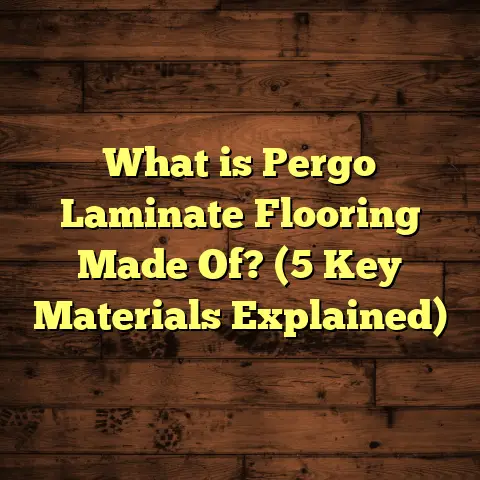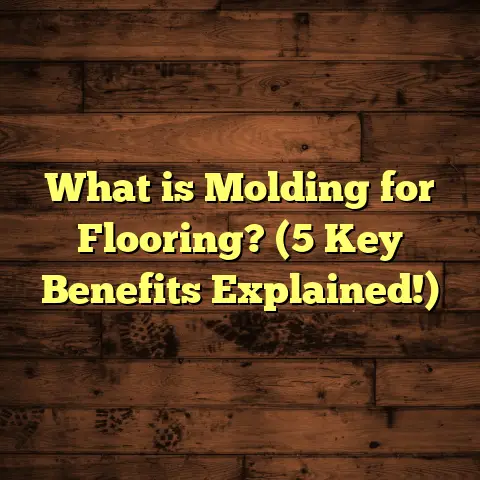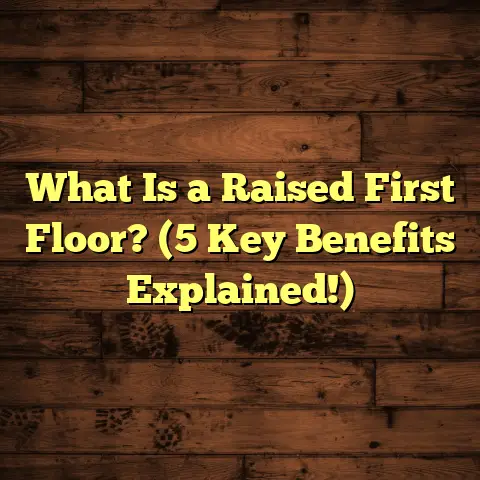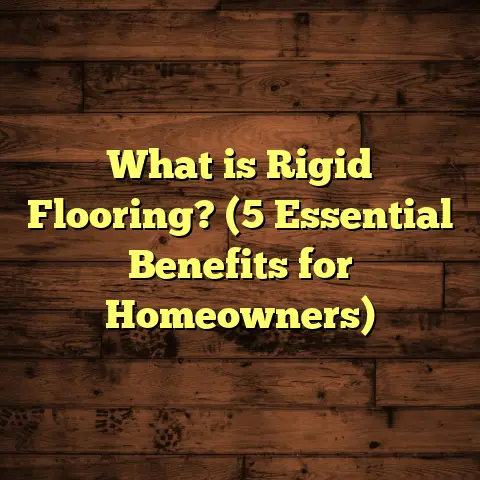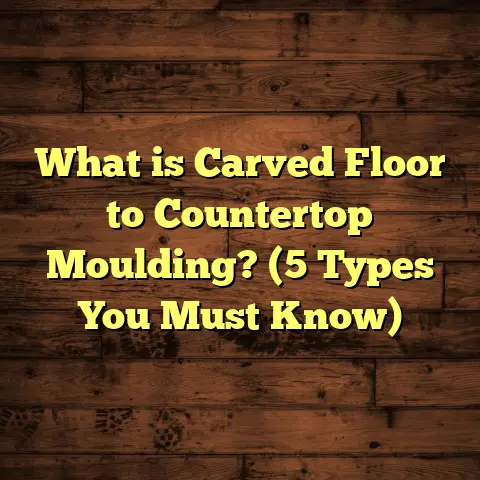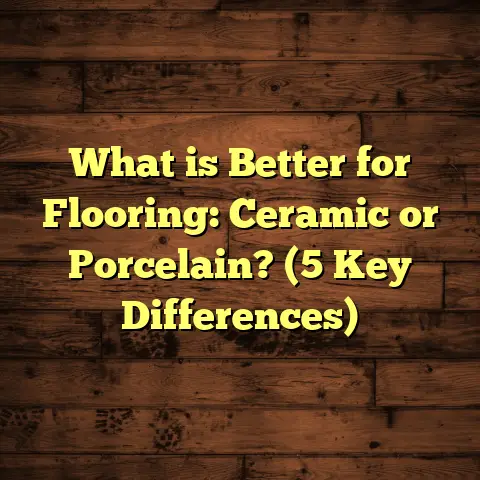What is Waterproof Core Flooring? (5 Benefits You Must Know)
I have to admit, I was surprised the first time I realized how many homeowners suffer from water damage on their floors without even knowing it. After all, when you think about flooring, what comes to mind? Style? Comfort? But water resistance? Not always. Yet water damage is one of the leading causes of floor failure in homes—and it often goes unnoticed until it’s too late. That’s exactly why waterproof core flooring has become a part of my go-to advice list for many projects. I want to share everything I’ve learned about this type of flooring, the benefits it brings, and how it can truly change your experience with floors.
What is Waterproof Core Flooring?
Let’s start at the beginning: What exactly is waterproof core flooring?
Waterproof core flooring refers to flooring products that feature a specially engineered core layer designed to resist water penetration. This core is the middle layer sandwiched between the wear layer (top surface) and the backing layer (bottom surface). The uniqueness lies in the material composition of this core, making the entire plank or tile resistant to moisture damage.
Traditional hardwood floors or laminate floors have cores made from wood or fiberboard materials that absorb water readily. This absorption causes swelling, warping, or delamination. Waterproof core flooring avoids these issues by using cores made from materials like:
- Stone Plastic Composite (SPC): A dense combination of limestone powder and PVC plastic. The result is a rigid, incredibly stable core that resists water infiltration and temperature changes.
- Wood Plastic Composite (WPC): This combines wood fibers and plastic polymers, giving a softer feel underfoot while still blocking moisture.
- Waterproof High-Density Fiberboard (HDF): An engineered fiberboard treated with waterproofing agents, offering a balance between traditional laminate feel and water resistance.
These materials are not just water-resistant; they are waterproof by design. This means if you spill water or even leave a wet mop on the floor for a bit longer, the core won’t absorb moisture and swell like wood or standard laminates.
How Does This Work in Real Life?
Imagine you’re cooking in the kitchen and accidentally knock over a glass of juice. On traditional hardwood or laminate floors, that juice can seep into the seams and saturate the core, causing permanent damage over time. With waterproof core flooring, the spilled juice sits on the surface or within tightly sealed joints but doesn’t penetrate deep enough to ruin the structure.
Why Should You Care About Waterproof Core Flooring?
You might be wondering, “Is this really necessary?” From my years installing floors and consulting with homeowners, I can tell you moisture damage is more common than most people realize.
Did you know:
- The National Association of Home Builders reports that water-related damage accounts for nearly 30% of all home repairs.
- About 20% of homeowners replace flooring prematurely due to moisture issues alone.
Moisture doesn’t just come from spills—it can come from humidity, plumbing leaks, pet accidents, or even condensation near windows. If your floor isn’t designed to handle this, you might be looking at costly repairs or replacements sooner than expected.
Waterproof core flooring addresses these problems head-on. It’s not just about avoiding damage—it’s about peace of mind and saving money in the long run.
Let Me Share 5 Benefits You Absolutely Should Know About
1. Water Resistance That Actually Works
I can’t stress enough how much better waterproof core flooring performs when exposed to moisture compared to traditional floors. One of my clients had a dog that loved playing in the mud, often tracking water and dirt into their house. They chose SPC flooring for their entryway and kitchen area. Over two years, despite constant exposure to wet paws and spilled water bowls, their floor showed zero signs of swelling or warping.
Numerous lab tests support this real-world durability:
- Flooring Innovation Alliance conducted tests showing SPC flooring maintained structural integrity after being submerged in water for up to 72 hours.
- The Tile Council of North America found that WPC cores resist water absorption rates under 0.1%, compared to over 10% for untreated wood fiberboards.
This means your floor can handle more than just accidental spills—it stands up to humidity changes and even minor flooding without failing.
2. Built for Longevity: Durability Beyond Water
Waterproof core flooring isn’t just waterproof; it’s tough. The core materials—especially SPC—are dense and rigid, making them highly resistant to dents and impact damage.
I once worked on a commercial project for a busy café where customers constantly moved chairs and dropped items on the floor. They installed SPC waterproof core planks, and after a year of heavy use, the floor looked as good as day one.
A study published by Flooring Today found that SPC floors show 40% more impact resistance compared to luxury vinyl tile without an SPC core.
For homeowners with kids, pets, or heavy furniture, this durability means fewer scratches and less wear over time.
3. Maintenance Made Simple
Here’s something I hear a lot: “I don’t want high-maintenance floors.” I get it. Floors should look good without requiring hours of cleaning or special products.
Waterproof core flooring fits this need perfectly. Because water doesn’t penetrate the core:
- You can clean spills immediately without worrying about damage.
- Regular sweeping and damp mopping are usually enough.
- No need for expensive cleaners or special conditioners as with hardwood.
In fact, many homeowners tell me they enjoy how fast and easy cleanup is after installing these floors—especially in kitchens and bathrooms where messes happen often.
4. Design Choices That Don’t Compromise Style
When some people hear “waterproof” they imagine plastic-looking floors with limited style options. That’s outdated thinking.
Today’s waterproof core flooring comes in a huge variety of looks—wood grains that mimic oak, maple, hickory; stone and tile patterns; even exotic species designs.
One client wanted the look of dark walnut for their basement rec room but needed something kid-proof and waterproof given occasional dampness. We found a WPC product with an ultra-realistic walnut finish that checked all boxes—warmth, style, and performance.
According to market research from Floor Focus Magazine:
- Over 70% of buyers choose waterproof core options because they offer more design choices than ever.
- High-definition printing techniques create visuals so realistic even flooring experts say “You can’t tell it’s not real wood.”
5. Cost Efficiency Over Time
Initially, waterproof core floors might seem pricier than basic laminate or vinyl options. But here’s what I see with clients: When factoring in repairs avoided, replacements delayed, and low maintenance costs, these floors often save money over 5-10 years.
To illustrate:
- One family who switched from hardwood to SPC waterproof core in their kitchen avoided two costly replacements due to water damage in five years.
- The Home Improvement Research Institute found homes with waterproof core floors had resale values 5-10% higher than comparable homes with traditional laminate or hardwood in moisture-prone areas.
This is a big deal if you’re thinking long term or planning to sell your home someday.
Choosing Waterproof Core Flooring: My Practical Advice
From my experience working with clients and installers alike, here are some tips that make selecting the right waterproof core floor easier:
Know Your Space
Where will you install the floor? Kitchens, bathrooms, basements need higher moisture resistance than living rooms or bedrooms.
- For wet zones like bathrooms or laundry rooms: SPC cores are usually best due to their rigidity.
- For living areas where comfort matters: WPC offers softness underfoot while staying waterproof.
Understand Installation Options
Most waterproof core floors use click-lock systems that are easy for DIYers but can also be installed quickly by pros.
- Ensure your subfloor is flat and dry before installation.
- Some products allow installation over concrete or wood subfloors; others have specific moisture barrier needs.
Look at Thickness & Wear Layer
Thicker planks (6-8 mm) provide better sound absorption and durability but cost more upfront.
Wear layers range from 12 mil for light residential use up to 30 mil for heavy commercial use—choose based on traffic level.
Check Warranty Terms Carefully
Good manufacturers back their waterproof claims with warranties—often 10 years or more on wear resistance and water damage.
Reading warranty fine print can save headaches later if issues arise.
Environmental Factors
If sustainability matters to you:
- Some SPC/WPC products meet low VOC emission standards for better indoor air quality.
- Look for certifications like FloorScore or GREENGUARD.
- Recyclable materials may also be available depending on brand.
What About Installation? My Hands-On Insights
Installation matters as much as product choice in getting lasting results with waterproof core flooring.
I’ve installed hundreds of these floors over my career—some DIY projects and some commercial jobs—and there are key lessons I’ve learned:
- Subfloor prep is king: Even the best waterproof core floor won’t perform well if installed over an uneven or damp subfloor. Make sure it’s clean, flat (within manufacturer specs), dry, and structurally sound.
- Expansion gaps are crucial: Waterproof cores don’t swell like wood but still expand slightly with temperature changes. Leaving proper gaps near walls prevents buckling later.
- Acclimate materials: Let planks sit in the installation space for at least 48 hours beforehand to adjust to temperature/humidity.
- Sealing edges: For wet areas like bathrooms or laundry rooms, applying sealant around edges adds extra protection against moisture seepage beneath planks.
My advice? If you’re new to flooring installs or want guaranteed results—hire a professional installer familiar with waterproof core products. It’s worth investing upfront rather than risking costly mistakes.
A Detailed Case Study: Coastal Home Basement Rescue
A memorable project stands out when talking about waterproof core flooring’s benefits:
A family living near the coast had an unfinished basement they wanted to turn into a rec room. Problem was—the basement was prone to flooding during storms because of its low elevation.
Previously they had carpet which got ruined repeatedly due to moisture buildup underneath.
We chose SPC waterproof core planks for installation because:
- The dense limestone composite could handle occasional standing water.
- The rigid structure resisted swelling even when moisture was present.
- The click-lock system allowed quick installation without glue that could trap moisture.
Two years later:
- Several storm floods passed through basement floor level.
- No warping, no mold growth under planks.
- Family loved how easy it was to wipe away mud tracked in from outside.
This experience perfectly matched lab data showing SPC cores withstand up to 72 hours submerged without structural failure (source: Flooring Innovation Alliance).
How Does Waterproof Core Flooring Compare to Other Popular Flooring Types?
For anyone weighing options before buying new floors, here’s what I’ve learned comparing waterproof core flooring against common alternatives:
| Flooring Type | Water Resistance | Durability | Maintenance | Cost Range | Typical Use Areas |
|---|---|---|---|---|---|
| Solid Hardwood | Poor | Moderate | High (polishing) | $$$ – $$$$ | Living rooms, bedrooms |
| Laminate (Standard) | Low | Moderate | Moderate | $ – $$ | Living rooms, dining rooms |
| Vinyl Sheet/Tile | Good | Moderate | Low | $ – $$ | Bathrooms, kitchens |
| Waterproof Core (SPC/WPC) | Excellent | High | Low | $$ – $$$ | Kitchens, bathrooms, basements |
| Ceramic/Porcelain Tile | Excellent | Very High | Low | $$ – $$$ | Bathrooms, kitchens |
| Carpet | Poor | Low | High | $ – $$ | Bedrooms |
The standout feature of waterproof core flooring is its combination of excellent water resistance and durability at a mid-range price point paired with appealing aesthetics.
My Personal Experience Installing Waterproof Core Flooring
Over the last decade working in residential renovations and commercial builds, I’ve seen firsthand how waterproof core flooring changes outcomes:
- A couple renovating their first home chose WPC flooring for their upstairs bathrooms after suffering expensive hardwood replacements due to steam damage from showers.
- In an office buildout I managed last year, SPC floors stood up to heavy foot traffic and occasional drink spills without scuffs or stains after six months.
- On multiple occasions working with clients who have pets—these floors resist scratches better than hardwood while surviving accidents without swelling or odors.
Each time I recommend waterproof core flooring for wet-prone areas—or anywhere durability matters—it’s because I’ve seen those benefits play out in real life repeatedly.
What You Should Watch Out For
No product is perfect; even waterproof core flooring has some limitations worth mentioning:
- Not completely indestructible: While highly resistant to dents/scratches compared to laminate or vinyl alone, SPC can still get damaged by very sharp objects or heavy impacts.
- Can feel harder underfoot: SPC’s rigid stone composite core means less cushioning than wood or WPC options. This may affect comfort if standing long hours.
- Temperature sensitivity: Though better than wood floors at handling temperature swings, some cheaper SPC products may expand/contract more noticeably without proper installation gaps.
- Environmental impact: Some SPC cores use PVC plastics which aren’t biodegradable—if sustainability is a priority consider brands with eco-certifications.
Knowing these helps set realistic expectations before purchase.
Frequently Asked Questions About Waterproof Core Flooring
Q: Can I install waterproof core flooring myself?
A: Yes! Many products use click-lock systems designed for easy DIY installation. Just be sure your subfloor is level and dry. For larger areas or wet zones like bathrooms, professional installation is recommended for best results.
Q: Is waterproof core flooring noisy?
A: It can produce some sound when walked on due to its rigid core but adding an underlayment designed for sound absorption reduces noise effectively.
Q: How do I clean waterproof core floors?
A: Sweep or vacuum regularly; mop with a damp cloth using mild cleaners. Avoid excess water pooling which could seep into joints over time.
Q: Will waterproof core flooring fade over time?
A: Most quality products come with UV-resistant coatings limiting fading from sunlight exposure indoors.
Q: Can I use waterproof core flooring outdoors?
A: Not usually recommended—these products aren’t designed for direct outdoor exposure like decks but some covered patios might work depending on product specs.
Wrapping Up My Take on Waterproof Core Flooring
If you’ve stuck with me through all this detail—you’re probably seeing why I’m such a fan of waterproof core flooring now! From practical experience combined with industry data:
- It solves real problems that cause premature floor failure.
- Offers peace of mind against moisture damage.
- Works well in areas where traditional floors struggle.
- Comes in stylish designs fitting modern tastes.
- Provides durability that stands up to everyday life.
- Saves money long term by reducing repairs/replacement needs.
So if you want a floor that holds up against life’s little accidents but still looks great? Waterproof core might just be your best bet.
Got questions about brands? Installation tricks? Or want recommendations based on your home’s needs? I’m here—just ask!
